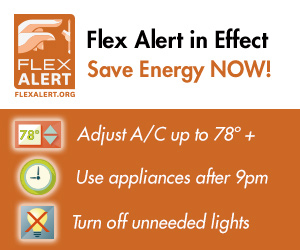With triple-digit temperatures forecast for the coming week, state officials are calling on all Californians to reduce their energy use to prevent power outages.
Key to helping relieve the pressure the heatwave is putting on the energy grid is limiting energy use from 3 p.m. to 10 p.m. — meaning air conditioning, electric car charging and other energy-intensive technology.
The state Office of Emergency Services (OES) suggest over-cooling homes overnight and in the morning to stay cool all day.
Californians can sign up to receive Flex Alert notifications from their utility provider to help the state conserve energy during times of grid stress. Below are other tips from the OES.
Easy Actions You Can Take at Home
- Adjust Your Thermostat
- Set your thermostat at 78 degrees or higher from 3 p.m. – 10 p.m.
- Pre-cool your home by setting thermostats to 72 degrees in the early part of the day (when it’s more efficient) and 78 degrees or higher after 3 p.m.
- Use smart or programmable features to help maintain energy savings when you’re not home.
- Major Appliance Use
- Postpone using major appliances like the oven, dishwasher and clothes washer, until cooler times of the day.
- Run your dishwasher and clothes washer only when full.
- Wash clothes in cold water.
- Clean or replace dirty filters.
- Turn your water heater down to 120 degrees or the “normal” setting.
- Close Windows and Doors
- In the morning before the day starts to heat up, close windows and blinds to keep warm air out.
- Keep windows and doors closed to prevent the loss of cooled air.
- Smart Energy Use
- Turn off unnecessary lights.
- Use lamps with LEDs instead of overhead lights.
- Enable “power management” on all computers and turn off when not in use.
- Unplug phone charges, power strips (those without a switch) and other equipment when not in use.
- Conservation Programs
- Consider participating in your utility’s demand response program. These voluntary programs are short, temporary measures to reduce energy consumption when power supplies are critically low and a Flex Alert has been issued. Contact your local electric utility to learn about your utility’s program and incentives they may offer to participate.
Save Energy at Work
- Lighting
- Turn off unnecessary office lights and use natural lighting where possible.
- Thermostat
- In the summer, set your zone thermostat to 78 degrees or higher, when possible.
- Prevent Leaks
- Check window vents to make sure they’re clear of paper and other debris.
- Adjust the blinds on windows that receive direct sunlight
- Keep exterior windows and doors closed to prevent the loss of cooled or heated air.
- Equipment
- Turn off any office equipment that is not currently in use. Alternately, look for sleep or power-saving modes in-between uses during the day.
- Enable power management settings on all computers, so that they go to sleep and turn off screens when not in use.
- Break room
- Unplug electronics such as coffee makers and microwaves when not in use and when the day is done.
- End-of-the-Day
- As you leave the office, get in the habit of checking to make sure computers, printers/copiers and other office equipment is fully shut down. If possible, switch them off at the power strip to ensure they’re no longer draining energy.
- Conservation Programs
- Consider enrolling in your utility’s voluntary conservation program. These types of measures — also known as demand response programs — are short, temporary ways for your utility to reduce energy consumption when power supplies are critically low. Contact your electric utility to learn more about your utility’s program and incentives they may offer to participate.
For more information, visit www.flexalert.org.



